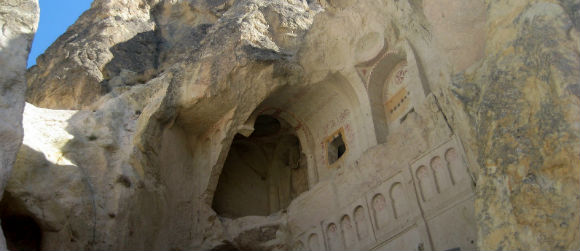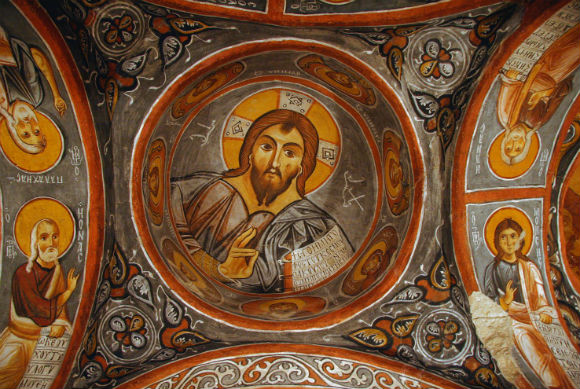The Dark Church is the most important sight in Goreme open-air museum and is the most richly decorated of the churches here. Lit by only one skylight, the darkness has preserved the frescoes, which have been carefully restored and can now be seen in all their glory. In one of the frescoes, representing the Last Supper, Jesus and his apostles are depicted with remarkable skill and portrayed with gentle, serene expressions. This masterpiece was the work of a brilliant artist from Constantinople.
The entrance to this church is from the north through a winding tunnel which opens into a barrel-vaulted narthex. In the south of the narthex there are three graves, two of which are big and the other is small.
The church has across plan, the arms of the cross having a diagonal vault. The templon of the main apse has been destroyed. In the northern apse Mother Mary and the infant Jesus have been painted on a blue background. In the southern apse is Abraham, the founder of Jesus’s family tree. In the central dome there is the Pantocrator Jesus, and in the four small domes are the four archeangels: Gabriel, Michael, Raphael and Azrael.
This church, which had received a lot of damage since the 7th century, took twelve years to restore by a team consisting of Turkish, French, Italian and Polish specialtists.
It is called the Dark Church because it gets very little light from the window in the narthex, and for this reason the colours are still very bright.
The narthex and the church itself are richly decorated with scenes related to the lives of Mary and Jesus. As in the Apple and Sandal Churches, there are also scenes from the Old Testament. The Deesis scenes in the main apse was painted using the fresco technique (directly onto wet plaster), which is very rare in Cappadocian churches, and one can still see the fingerprints of the artists on the faces of Jesus, Mary and John the Baptist.
This church was originally built by donatiofis from eight sponsors: two of whom can be seen depicted in the narthex, two in the apse, and four near the archeangels on the walls. The name of the donor in the narthex, depicted while praying to Jesus, is Nicephorus, and his inscription reads, “icephorus’ prayer, the servant of God”.
The donors were painted on the most honoured parts of the church, a feature unique to this part of the world. The other important scenes in the church are the four Evangelists, painted on the northern and eastern walls, and the doctors Domian and Cosmas who were also saints on the northern wall, shown with medical instruments in their hands. This Church dates from the end of the l2th and the beginning of the l3th centuries.
Dark Church (Karanlık Kilise),



Dark Church and Buckle Church both of them are professionaly restored by the Unesco.
After visit all the cave churches and the one that really blew me away was the Dark Church.
The entrance and a limited visit time of 8minutes per person/ group… I got out of there with a smile. The 11th century frescoes with their colors, details, techniques are beautifully preserved!
I believe it was the only church where the eyes of painted figures weren’t scratched off because they were covered with pigeon droppings. It was used as pigeon house until the 1950’s and it took a team of professionals 14 years to restore its fine example of Byzantine art. Don’t mind the small amount of light coming in… this is what preserved the coloring so well through time!
Overall the cave churches are in a remarkably good condition considering they were built 1000 of years ago.